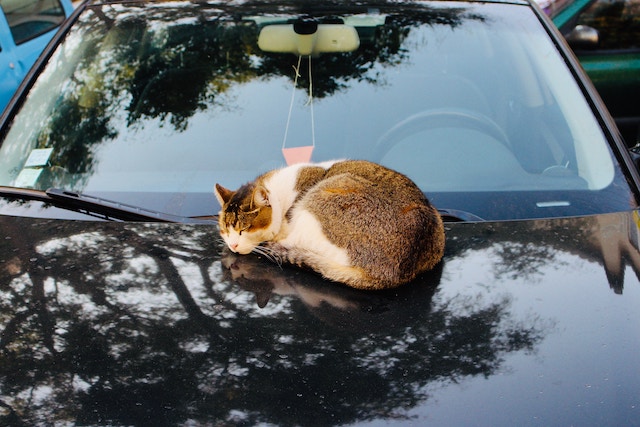Taking a road trip across the country can be an exciting adventure, but adding a furry friend to the mix can make it even more fun.
Cats can make great travel companions, but it’s important to be prepared and know what to expect when traveling long distances with your feline friend.
Let’s talk about everything you need to know about driving cross country with a cat.
Before the Trip
Before you hit the road with your cat, it’s important to make sure they’re comfortable with car travel.
Start by taking short trips around town, gradually increasing the length of the trips to get your cat used to being in the car. If your cat becomes anxious or uncomfortable during car rides, you may want to consider using a pheromone spray or medication to help calm them down. Be sure to consult with your veterinarian about these options.
In addition to getting your cat used to car travel, you’ll also need to make sure they’re up to date on their vaccinations and have a health certificate from your veterinarian. You’ll need this certificate if you plan to cross state lines during your trip.
It’s also a good idea to have your cat microchipped in case they become lost during the trip.
Preparing for the Trip
When it comes to preparing for a cross-country road trip with a cat, there are several things you’ll need to consider.
First, ensure your cat has a comfortable and secure carrier that is big enough for them to stand up, turn around, and lie in. You may want to consider lining the carrier with a soft blanket or towel for added comfort.
You’ll also need to pack plenty of food, water, and litter for your cat. Make sure to bring enough food and water for the entire trip, as it may be difficult to find your cat’s preferred brand on the road.
Consider bringing a collapsible litter box or disposable litter trays for your cat to use during rest stops.
During the Trip
When you’re on the road with your cat, it’s important to keep their safety and comfort in mind.
Make sure your cat is secured in their carrier while the car is moving, as this will help prevent injuries in the event of an accident or sudden stop.
You may also want to consider covering the carrier with a towel or blanket to help your cat feel more secure and prevent them from becoming overstimulated by the passing scenery.
It’s also important to keep your cat’s routine as consistent as possible during the trip.
Stick to their regular feeding and litter box schedule as much as possible, and provide them with plenty of opportunities to stretch their legs and exercise during rest stops. However, be sure to keep your cat on a leash or harness during rest stops, as they may be easily startled by unfamiliar surroundings and attempt to run off.
In addition to keeping your cat comfortable and safe, it’s also important to consider the safety and comfort of other passengers in the car.
If anyone in the car is allergic to cats, consider using an air purifier or keeping the carrier in a separate area of the car to minimize exposure to allergens.
Crossing State Lines
If you plan to cross state lines during your trip, knowing any state-specific requirements for traveling with a pet is important.
Some states require a health certificate or proof of rabies vaccination, while others may restrict certain breeds of cats or exotic animals. Be sure to research the requirements for each state you plan to visit well before your trip to avoid any surprises or delays.
Hotels and Accommodations
When planning your trip, make sure to research pet-friendly hotels and accommodations along your route.
Many hotels and motels allow pets but may restrict the number or size of pets allowed in each room. Some hotels may also charge a pet fee or require a deposit, so be sure to factor these costs into your travel budget.
When staying in a hotel or other accommodation with your cat, be sure to bring their carrier and litter box with you.
Keep your cat in the carrier while in the hotel room to prevent them from becoming lost or hiding in a difficult-to-find location. Consider using a towel or blanket to cover the hotel room furniture to prevent cat hair from getting on the upholstery.
If you plan to camp or stay in an RV during your trip, make sure to research pet-friendly campgrounds and RV parks.
Remember that some campgrounds may have restrictions on certain breeds of cats, so be sure to check with the campground before booking your stay.
Emergency Preparedness
Finally, it’s important to be prepared for any emergencies that may arise during your trip.
Make sure to bring a first-aid kit for your cat and any necessary medications or supplements.
Keep your veterinarian’s contact information on hand in case of a medical emergency, and research emergency veterinary clinics along your route.
If your cat becomes lost during the trip, make sure they are wearing a collar with identification tags and have their microchip information up to date. You may also want to consider bringing a recent photo of your cat with you to help with identification.
Final Thoughts: Driving Cross Country With a Cat Doesn’t Have to Be Stressful
Driving cross country with a cat can be a fun and rewarding experience, but it’s important to be prepared and plan ahead to ensure your cat’s safety and comfort.
By following the tips we’ve shared, you can help make the cross country drive a good experience for you and your cat.
Read Next: 7 Tips for Traveling With a Pet to Remember for Your Next Trip

